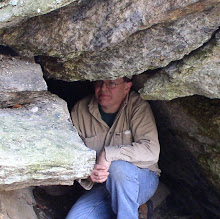A week later, I returned to the same basic range of mountains just east of the Connecticut River. This time it was to explore more southerly sections of the 'old Park' and reacquaint myself with the locations first studied over 15 years ago. And yes - the photography of Amherst's John Lovell figured prominently into this.
Several old mountain roads lead upward and trails often diverge from these roads. My first jaunt took me up through an area once occupied just past the mid 100s by the Ansel (A.C.) Delano sawmill. Beyond that, an area existed (not overgrown as it is today) called Paradise. Here I found several good examples of conglomerate ledges and very close by is one used by climbers called The Sunbowl.

Returning to my starting point, I relocated bit a bit to the north and hiked up the mountain via another old road. Here was a pretty worthy cascade that I believe photographer Lovell called Silver Cascade. It's not far from an old sugar house that once belonged to Nathaniel Smith. A magnificent glen lays below this cascade and might be the one portrayed in the old Lovell photography as Mossy Glen.
The remainder of the day was put in at a better know set of ledges once called The Bear's Den - or Home of the Rocks - that is covered in 12 different old stereoviews. My first stop here was at Russell Rock which is a relatively new photo to my collection. It can be found between the Kitchen and Pantry, and the Curve Rock. Finishing up here, I moved on to the area of the Grand Porch which seems to mark the entranceway to Titan's Pasture. I worked my versions of photography for the Porch and the beginning of the Pasture. On the way back, I had enough time to quickly snap Old Man Titan, a giant facial formation that watches out over the Valley in the vicinity of the Rock Shadow.
[For those wishing to explore some old-time geologic writing on this area, I would refer them to the "Cirques and rock-cut terraces of Mount Toby" by B.K. Emerson. This can be found in GSA Bulletin (1911) 22 (1): 681–686.]






